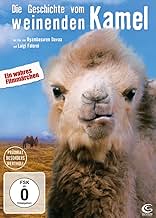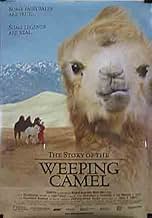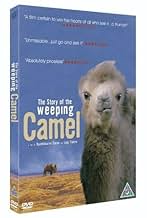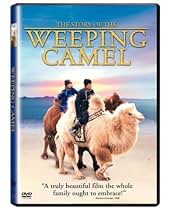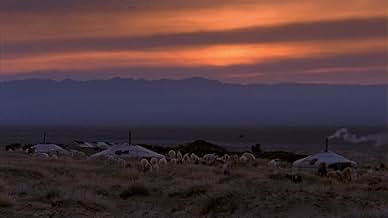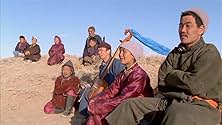L'histoire du chameau qui pleure
Titre original : Die Geschichte vom weinenden Kamel
- 2003
- Tous publics
- 1h 33min
NOTE IMDb
7,4/10
6,5 k
MA NOTE
Des nomades aide les chamelles à mettre bas. Dès la naissance, elle se désintéresse de son bébé et lui refuse son lait. La tradition veut qu'on fasse venir un violoniste pour émouvoir la cha... Tout lireDes nomades aide les chamelles à mettre bas. Dès la naissance, elle se désintéresse de son bébé et lui refuse son lait. La tradition veut qu'on fasse venir un violoniste pour émouvoir la chamelle et la réconcilier avec son bébé chameau.Des nomades aide les chamelles à mettre bas. Dès la naissance, elle se désintéresse de son bébé et lui refuse son lait. La tradition veut qu'on fasse venir un violoniste pour émouvoir la chamelle et la réconcilier avec son bébé chameau.
- Réalisation
- Scénario
- Casting principal
- Nommé pour 1 Oscar
- 10 victoires et 9 nominations au total
Avis à la une
We heard that National Geographic was involved with this film, so expected some first-class photography. We were not disappointed.
The setting is amongst an extended family group, eking out a simple, rural existence on the high desert plains of Mongolia. It is the end of the calving season, and the last camel in the herd remains to give birth. We are privileged to witness the event in an non-intrusive way. It is the mother's first delivery and she encounters difficulties, probably through inexperience, and the human attendants feel compelled to assist. Not easy, with such a large animal, but eventually a healthy while colt is born before our very eyes. One suspect possibly because of the human intervention, the mother rejects the little one, and brushes away its repeated attempts to feed. Before long, the offspring is isolated from the mother and herd. Its mournful wailing sounds permeate the still Mongolian atmosphere with a haunting melancholy which cannot fail to turn the viewer's heart. Repeated attempts are made to reconcile the colt and its mother. As they all fail, the family decides to embark on a traditional ceremony as a last resort. This involves engaging a violinist to play music to the pair - a solution not as easy as it sounds, for the nearest skilled musician is in a remote provincial town which is at least a decent camel ride away. He eventually arrives and the ceremony commences. The outcome is best left for the viewer, suffice to say that here we have a touching film, with the splendor of the Mongolian landscape and the soft gentle colours of its sunsets as a backdrop. Worthy of a rating of 8 out of 10.
The setting is amongst an extended family group, eking out a simple, rural existence on the high desert plains of Mongolia. It is the end of the calving season, and the last camel in the herd remains to give birth. We are privileged to witness the event in an non-intrusive way. It is the mother's first delivery and she encounters difficulties, probably through inexperience, and the human attendants feel compelled to assist. Not easy, with such a large animal, but eventually a healthy while colt is born before our very eyes. One suspect possibly because of the human intervention, the mother rejects the little one, and brushes away its repeated attempts to feed. Before long, the offspring is isolated from the mother and herd. Its mournful wailing sounds permeate the still Mongolian atmosphere with a haunting melancholy which cannot fail to turn the viewer's heart. Repeated attempts are made to reconcile the colt and its mother. As they all fail, the family decides to embark on a traditional ceremony as a last resort. This involves engaging a violinist to play music to the pair - a solution not as easy as it sounds, for the nearest skilled musician is in a remote provincial town which is at least a decent camel ride away. He eventually arrives and the ceremony commences. The outcome is best left for the viewer, suffice to say that here we have a touching film, with the splendor of the Mongolian landscape and the soft gentle colours of its sunsets as a backdrop. Worthy of a rating of 8 out of 10.
In the spring of the Gobi Desert, in South Mongolia, a nomadic family of shepherds has troubles when one camel has a tough two days delivery, immediately rejecting the offspring. The family unsuccessfully uses their best efforts trying to force the female to accept and feed the newborn. When there is no further hope of saving the animal, they send their two sons to bring a musician from the nearest town to perform a ritual and save the "baby camel".
I do not know, and I was really curious to know, how could be the original screenplay of this documentary. I believe the first intention of directors Byambasuren Davaa and Luigi Falorni would be to document the lifestyle of a nomadic family of shepherds, showing a different culture for the Westerners. However, fortune gave them the opportunity of sharing a great experience with the viewers with the ritual that brought the camel to accept the offspring. Thank you, Messrs. Byambasuren Davaa and Luigi Falorni, for such touching, beautiful and wonderful film. My vote is nine.
Title (Brazil): "Camelos Também Choram" ("Camels Also Weep")
I do not know, and I was really curious to know, how could be the original screenplay of this documentary. I believe the first intention of directors Byambasuren Davaa and Luigi Falorni would be to document the lifestyle of a nomadic family of shepherds, showing a different culture for the Westerners. However, fortune gave them the opportunity of sharing a great experience with the viewers with the ritual that brought the camel to accept the offspring. Thank you, Messrs. Byambasuren Davaa and Luigi Falorni, for such touching, beautiful and wonderful film. My vote is nine.
Title (Brazil): "Camelos Também Choram" ("Camels Also Weep")
If you are fed up with Hollywood glitz and special effects. If you are tired of hearing overpaid actors whining about how hard life is when having to film away from home, then you would be a fool not to watch this splendid film.
It would be too easy to say it is a documentary or a drama documentary. It is neither. It is, in the old term, 'cinema verite' at its best with good editing. Or even 'fly on the wall'. It is a truly wonderful story that has what many films should have: a beginning, a middle and an end.
I see no point in over analysing components of the film. To do so would destroy the theme. It is a story told in in the style of Aesop but it is far from a fable. The camera work (from a novice!) is stunning. There are no wild hand-held camera angles, just luscious close ups and exquisite panoramic views. Thankfully there are no blurred short depth of field shots - as is common in too many modern films.
It will leave you with a warm glow and hopefully raise many questions about the values that we as a human race share and are losing. If you have seen the Korean "The Way Home" you will love this contribution to the world of film. It is a truly excellent and heart warming experience.
It would be too easy to say it is a documentary or a drama documentary. It is neither. It is, in the old term, 'cinema verite' at its best with good editing. Or even 'fly on the wall'. It is a truly wonderful story that has what many films should have: a beginning, a middle and an end.
I see no point in over analysing components of the film. To do so would destroy the theme. It is a story told in in the style of Aesop but it is far from a fable. The camera work (from a novice!) is stunning. There are no wild hand-held camera angles, just luscious close ups and exquisite panoramic views. Thankfully there are no blurred short depth of field shots - as is common in too many modern films.
It will leave you with a warm glow and hopefully raise many questions about the values that we as a human race share and are losing. If you have seen the Korean "The Way Home" you will love this contribution to the world of film. It is a truly excellent and heart warming experience.
There's a new style of film eking into the film biz called "Narrative Documentary." What? An oxymoron you tutt-tutt silently as you read.Well, yes and no. It describes a documentary that has been embellished with narrative scenes to ultimately create the arc-drama one finds in a feature film with the intelligence of a documentary.
Narrative documentary is truly an appropriate expression for this wonderfully unique and intriguing little gem, The Story of the Weeping Camel.
As you watch the fairly simple tale of a camel that after a grueling birthing of her albino calf, she decides she's not interested in the ideas of motherhood and abandons the newborn to fend for itself.
Sounds positively dull until you start to watch this young mother and the footage the filmmakers gathered and you are pulled in - mesmerized, "How did the film crew get this?" It feels like a documentary, looks like a documentary but then there's the story obviously running along side the remarkable footage that you realize is scripted, storyboarded and a team behind the lens have planned. Amazing.
Narrative documentary is truly an appropriate expression for this wonderfully unique and intriguing little gem, The Story of the Weeping Camel.
As you watch the fairly simple tale of a camel that after a grueling birthing of her albino calf, she decides she's not interested in the ideas of motherhood and abandons the newborn to fend for itself.
Sounds positively dull until you start to watch this young mother and the footage the filmmakers gathered and you are pulled in - mesmerized, "How did the film crew get this?" It feels like a documentary, looks like a documentary but then there's the story obviously running along side the remarkable footage that you realize is scripted, storyboarded and a team behind the lens have planned. Amazing.
In the Gobi desert, where a nomadic tribe tends its camels like Jay Leno his automobiles, a mother rejects a white calf just delivered with difficulty. The society's initiative to bring mother to nurse the child is the center of an otherwise simple plot. The astounding cinematography (Yes, the desert is stunning even after 90 minutes) and the scrubbed-face happiness of the family are the real stars of this half documentary, half reenactment of a crisis every bit as important to this family as a birth is to a tightly-knit family anywhere in the rest of the world.
And yet a theme appears as I reflect on the happiness of this attractive clan: the emergence of modernism even in Mongolia. In two young men's 50-kilometer journey to find help for the camel, they discover television and computer games. The younger boy, fascinated by the technology, asks his father to purchase a TV. The grandfather gently offers his concern that the boy would be watching fleeting glass images-the case is closed, a powerful reminder of the benign presence of grandparents in this culture, the wisdom of elders, and the fresh-aired innocence of the clan, which will not give itself up easily to modern distractions. Besides, it is abundantly clear they don't need passive entertainment.
The ceremony to reconcile the mother and calf includes primitive music by a teacher and impressive solo singing by a young woman. No one could possibly turn to TV while watching this transcendent act. `Whale Rider's' heightened sense of the magical in the mundane and the unbelievable bond of young and old is the only other recent film I can think of to approach this film's simple power.
`The Story of the Weeping Camel' is as slow as the culture it shows, so be cautious about bringing restless city children. The story lingers on the actual birth of the white calf, possibly disconcerting to the younger, inexperienced members of the audience. Then why do the film's characters get such joy out of the minor warnings I just gave? It is their life, as blessed and happy as any you will see on film or anywhere else on earth.
The camel's soulful cry in the vast desert will stay with you. As Lafcadio Hearn said, `If you ever become a father, I think the strangest and strongest sensation of your life will be hearing for the first time the thin cry of your own child.' And that goes for the mother's cry as well.
A beautiful film out of time and step with a lesser world outside.
And yet a theme appears as I reflect on the happiness of this attractive clan: the emergence of modernism even in Mongolia. In two young men's 50-kilometer journey to find help for the camel, they discover television and computer games. The younger boy, fascinated by the technology, asks his father to purchase a TV. The grandfather gently offers his concern that the boy would be watching fleeting glass images-the case is closed, a powerful reminder of the benign presence of grandparents in this culture, the wisdom of elders, and the fresh-aired innocence of the clan, which will not give itself up easily to modern distractions. Besides, it is abundantly clear they don't need passive entertainment.
The ceremony to reconcile the mother and calf includes primitive music by a teacher and impressive solo singing by a young woman. No one could possibly turn to TV while watching this transcendent act. `Whale Rider's' heightened sense of the magical in the mundane and the unbelievable bond of young and old is the only other recent film I can think of to approach this film's simple power.
`The Story of the Weeping Camel' is as slow as the culture it shows, so be cautious about bringing restless city children. The story lingers on the actual birth of the white calf, possibly disconcerting to the younger, inexperienced members of the audience. Then why do the film's characters get such joy out of the minor warnings I just gave? It is their life, as blessed and happy as any you will see on film or anywhere else on earth.
The camel's soulful cry in the vast desert will stay with you. As Lafcadio Hearn said, `If you ever become a father, I think the strangest and strongest sensation of your life will be hearing for the first time the thin cry of your own child.' And that goes for the mother's cry as well.
A beautiful film out of time and step with a lesser world outside.
Le saviez-vous
- AnecdotesOfficial submission of Mongolia for the 'Best Foreign Language Film' category of the 76th Academy Awards in 2004.
- ConnexionsFeatured in The 77th Annual Academy Awards (2005)
Meilleurs choix
Connectez-vous pour évaluer et suivre la liste de favoris afin de recevoir des recommandations personnalisées
- How long is The Story of the Weeping Camel?Alimenté par Alexa
Détails
- Date de sortie
- Pays d’origine
- Sites officiels
- Langue
- Aussi connu sous le nom de
- The Story of the Weeping Camel
- Lieux de tournage
- Sociétés de production
- Voir plus de crédits d'entreprise sur IMDbPro
Box-office
- Montant brut aux États-Unis et au Canada
- 1 763 052 $US
- Week-end de sortie aux États-Unis et au Canada
- 21 767 $US
- 6 juin 2004
- Montant brut mondial
- 9 328 652 $US
- Durée
- 1h 33min(93 min)
- Couleur
- Mixage
- Rapport de forme
- 1.85 : 1
Contribuer à cette page
Suggérer une modification ou ajouter du contenu manquant


